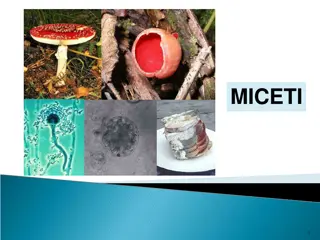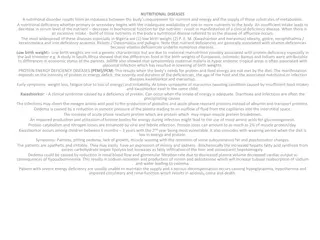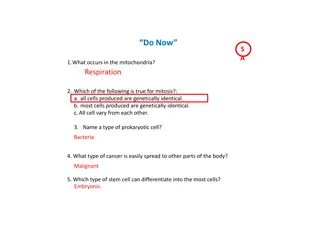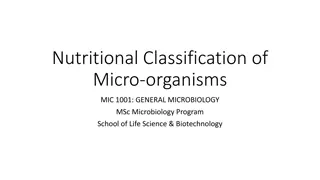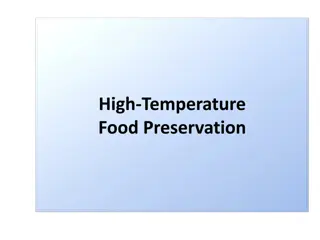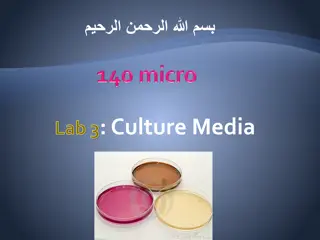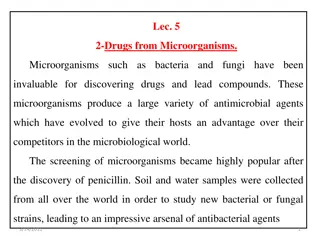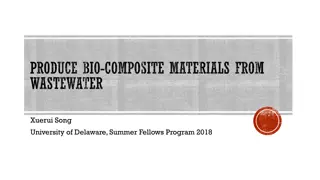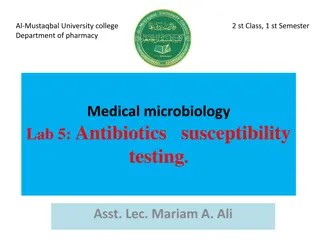Nutritional Requirements of Microorganisms
Nutritional requirements of microorganisms play a crucial role in their growth and functionality. The essential nutrients include carbon, oxygen, iron, macroelements, micronutrients, and trace elements. Microorganisms need a balanced mixture of nutrients for biosynthesis, energy release, and various metabolic processes. Different types of microorganisms, such as autotrophs and heterotrophs, have specific ways of obtaining and utilizing nutrients to support their growth and survival.
Download Presentation

Please find below an Image/Link to download the presentation.
The content on the website is provided AS IS for your information and personal use only. It may not be sold, licensed, or shared on other websites without obtaining consent from the author.If you encounter any issues during the download, it is possible that the publisher has removed the file from their server.
You are allowed to download the files provided on this website for personal or commercial use, subject to the condition that they are used lawfully. All files are the property of their respective owners.
The content on the website is provided AS IS for your information and personal use only. It may not be sold, licensed, or shared on other websites without obtaining consent from the author.
E N D
Presentation Transcript
Nutritional Requirement by Microorganisms
INTRODUCTION Nutrients are substances used in biosynthesis and energy release and therefore are required for microbial growth
Common Nutrient Requirements Carbon Oxygen Iron 95% cells dry weight Macroelements/ Macronutrients Magnesium Hydrogen Calcium Nitrogen Phosphorous Sulphur Potassium The first six (C, O, H, N, S and P) : components of carbohydrates, lipids and proteins K+: enzyme -protein synthesis Ca2+ : heat resistance of bacterial endospores Mg2+ : cofactors, stabilise the cell membrane and ribosomes Fe2+ and Fe3+ : part of cytochrome and cofactors for enzymes and ECP
Micronutrients/ Trace elements : Several nutrients which are required in small amounts Ubiquitous and normally part of enzymes and cofactors Aid in catalysis of reaction and maintenance of protein structure Mn2+: transfer of phosphate groups Manganese Mo2+ : nitrogenfixation Co2+ : component of vitaminB12 Copper Zinc Micro nutri ents Nickel Cobalt Molybdenum Hence microorganisms require a balanced mixture of nutrients
Requirements for Carbon, Hydrogen, Oxygen and Electrons All organisms need carbon, oxygen, hydrogen and source of electrons CARBON : Skeleton/backbone of all organic molecules from which the organism is built HYDROGEN & OXYGEN: Important elements found in the organic molecules ELECTRONS Electron transport chain and the oxidation reduction reactions- energy for use in cellular work reduced Reduce molecules during biosynthesis (CO2 molecules) organic
AUTOTROPHS : use only CO2 as a sole source of carbon obtain energy from light or reduced inorganicmolecule Because CO2 cannot supply their energy needs, they must obtain energy from other sources, such as light or reduced inorganic molecules HETEROTROPHS : organisms that use reduced, preformed organic molecules as their carbonsource Heterotrophic microorganisms has extraordinary flexibility with respect to carbon sources Actinomycetes : common soil bacteria degrade the paraffin, amyl alcohol and even rubber Burkholderia cepacia : use 100 different carbon compounds Leptospira : use long chain fatty acids as the major source of carbon
Microorganisms can be classified as autotrophs or heterotrophs on the basis of the preferred source of carbon. There are two sources of energy available to organisms. Light energy: Chemical energy: Energy derived from oxidising organic or inorganic molecules. PHOTOTROPHS : Use light as energy source CHEMOTROPHS : energy obtained from oxidation of chemical compounds LITHOTROPHS (rock eaters) : Reduced inorganic substance as energy source ORGANOTROPHS : extract electrons from reduced organic source Majority of the microorganisms studied so far are Photolithotrophic autotrophs or chemoorganotrophic heterotrophs
Major nutritional types of microorganisms NURTIONAL TYPE CARBON SOURCE ENERGY SOURCE ELECTRON SOURCE REPRESENTATIVE MICROORGANISMS Photolithography CO2 Light Inorganice- donor Purple and green sulfur bacteria, cynobacteria Photoorganoheterophy Organic carbon Light Organic e- donor Purple nonsulfur bacteria, green nonsulfurbacteria Chemolithoautotrophy CO2 Inorganic chemicals Inorganice- donor Sulfur, iron, hydrogen- oxidizing bacteria, methanogens Chemolithoheterotrophy Organic carbon Inorganic chemicals Inorganic e- donor Some sulfur oxidizing bacteria Chemoorganoheterotrophy Organic carbon Organic chemicals Organice- donor Fungi, protists and many archaea
Phototrophic Bacteria Phototrophic bacteria play important roles in aquatic ecosystems, where they can cause blooms (a) A cyanobacterial and an algal bloom in a eutrophicpond (b) Purple sulfur bacteria growing in a bog (c) A bloom of purple sulfur bacteria in a sewage lagoon
Chemolithotrophic Bacteria (a)Transmission electron micrograph of Nitrobacterwinogradskyi,an organism that uses nitrite as its source of energy (b)Light micrograph of Beggiatoa alba, an organism that uses hydrogen sulfide as its energy source and organic molecules as carbon sources. The dark spots within the filaments are granules of elemental sulfur producedwhen hydrogensulfide is oxidized
Requirements for Phosphorus, Nitrogen and Sulfur Nitrogen : synthesis of amino acids, purines, pyrimidines, some carbohydrates and lipids, enzyme cofactor Some incorporate ammonia directly through the action of enzymes such as glutamate dehydrogenase or glutamine synthetase and glutamine synthase Phototrophs and chemotrophic microbes Assimilatory Incorporated Nitrate Ammonia nitrate reduction Nitrogen Fixation : Variety of bacteria (Cyanobacteria, Symbiotic bacterium Rhizobium) Assimilate atmospheric nitrogen (N2) by reducing it to ammonium
Phosphorus Phosphorus present in nucleic acid, phospholipids, nucleotides (ATP), cofactors, some proteins and other cellcomponents Use of inorganic phosphate as phosphorous source which is directly incorporated Aquatic environments : Low phosphate levels limits microbialgrowth E.coli uses organic and inorganic phosphate Organophosphate Others Hexose 6-phosphate Transported across plasma membrane T aken up directly by the cell Inorganic Phosphate
Sulfur Microorganisms use sulfate as a source ofsulfur Reduce it by assimilatory sulfatereduction Amino acids Reduced form of sulfur such as cysteine is alsoused Sulfur Thiamine Biotin Carbohy drates
Growth Factors Organic compounds that are essential cell components or precursors of such components but cannot be synthesised by theorganism Vitamin Biotin Functions One carbon metabolism,CO2 fixation Examples Leuconostoc mesenteroids Saccharomyces cerevisiae Acanthamoebacastellanii Folic acid Onecarbon metabolism Tetrahymena spp. Enterococcus fecalis Riboflavin (B2) Precursor of FAD & FMN Caulobacter vibriodes Dictyostellium spp. Thiamine(B1) Aldehyde group transfer Bacillus anthracis Colpidium campylum Ochromonas malhamensis Pantothenic acid Precursorof coenzyme A Proteus morganii Functions of some common vitamins in microorganism
Uptake of nutrients by the cell Diffusion Nutrient uptake Active transport Group translocation
Culture Media A solid/liquid preparation used to grow, transport, and store microorganisms Complex liquid media (urine, chicken/ meat broth)- Louis Pasteur Solid media (Potato surface, gelatin): Robert Koch Gelatin melts at 24 C Microbes used it as a substrate Agar was first described for use in microbiology by Walter Hesse
Culture Media Oxidatio n reductio n Carbon source Energy source InhibitpoortentiRalequirement Nitrogen source s s of culture media Indicator s Salts Growth factors pH
Culture Media Types of Media Physical Nature Functional Type Chemical Composition Liquid Defined Supportive Semi solid Complex Enriched Solid Selective Differential
Culture Media Liquid and solidified media are routinely used in microbiology labs, solidified media are particularly important Both defined and complex media can be solidified with the addition of 1.0 to 2.0% agar; most commonly 1.5% is used Agar Sulphated polymer (D-galactose, 3,6-anhydro-L-galactose, and D-glucuronic acid) Extracted from red algae Melting temperature- about 90 C and Solidifying temperature- 45 C Microbes growing on agar medium can be incubated at a wide range of temperatures Agar is an excellent hardening agent because most microorganisms cannot degrade it Other solidifying agents -silica gel is used to grow autotrophic bacteria
Culture Media Defined or Synthetic medium medium. All chemicalcomponents areknow n in defined Can be in a l agar an agent such as iquid form (broth) or solidified by Widely used in research, as it isoften desirable to know what the experimental microorganismis g metabolizin Culture photosynthetic protists),chemoorganotrophich otolithotrophic ph nobacteria eterotrophs and autotrophs (cya constructed from All defined m edia are as simple, b ut may be dozens of components
Culture Media Complex media Media that contain some ingredients of unknown chemical composition Single complex medium may be sufficiently rich to completely meet the nutritional requirements of many different microorganisms The nutritional requirements of a particular microorganism are unknown, and thus a defined medium cannot be constructed Undefined components like peptones, meat extract, and yeast extract Nutrient broth, tryptic soy broth, and MacConkey agar Tryptic Soy Broth Amt (g/ltr) Tryptone (pancreatic digestof casein) 17 Peptone (soybeandigest) 3 Glucose 2.5 Sodiumchloride 5 Dipotassiumphosphate 2.5
Functional types of media General purpose media or supportive media: they sustain the growth of many microorganisms. Ex: tryptic soy broth and tryptic soy agar Enriched media: Blood and other special nutrients may be added to general purpose media to encourage the growth of fastidious microbes. These specially fortified media (e.g., blood agar) Selective media: favour the growth of particular microorganisms Differential media: are media that distinguish among different groups of microbes and even permit tentative identification of microorganisms based on their biological characteristics (e.g., blood agar: hemolytic and non-hemolytic bacteria)



